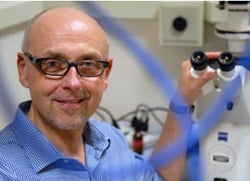Vittorio Gallo, PhD, Director of the Center for Neuroscience Research at Children's National Health System, Examines Regeneration and Repair of Glial Cells in Central Nervous System

While neurons often gain attention in brain research, the more unpublicized glial cells–meaning “glue” in Greek–play an integral role in the restoration of an injured central nervous system and can open the door to innovation and change, says Vittorio Gallo, PhD, Director of Children’s National Health System’s Center for Neuroscience Research, and Director, Intellectual and Developmental Disabilities Research Center, in Neuron Magazine.
Glial cells, which comprise at least 50 percent of the cellular constituency of the brain and are involved in all forms of injury and disease response, recovery, and regeneration, are the “holy grail of regenerative medicine,” Dr. Gallo says. The central nervous system consists of neurons, which carry nerve impulses, and glial cells, which provide multiple functions to both the central nervous system and the peripheral nervous system.
Gallo and co-author Benjamin Deneen, PhD, at the Department of Neuroscience and the Center for Cell and Gene Therapy at Baylor College of Medicine in Houston, Texas, described key molecular processes underlying glial regeneration and repair under pathological conditions in Glial Development: The Crossroads of Regeneration and Repair in the CNS, referring to the central nervous system.
“While injury and pathological states in the adult are comparatively more complex than embryonic and early postnatal development, viewing regeneration through the eyes of development lends clarity as well as a starting point for greater insight into the fundamental process governing glial repair,” Drs. Gallo and Deneen wrote. “Given the complexities of the mammalian CNS, its regeneration is reviewed as the holy grail of regenerative medicine.”
Evolving and significant progress in understanding glial development “continues to raise important questions about the roles of these cells in human neurological disorders and brain injury,” according to Drs. Gallo and Deneen. Because glial cells play crucial roles in nearly all brain pathologies, “defining their role in brain diseases” will also provide important information about their function, they added.
Understanding glial development can open the door for further research into this tantalizing area of neurology. “Extraordinary efforts have been made to understand developmental neurogenesis, with the hopes of clinically applying this knowledge,” Drs. Gallo and Deneen wrote. Now, we should pay more attention to glia, they said.
Contact: Joe Cantlupe at 202-476-4500.



